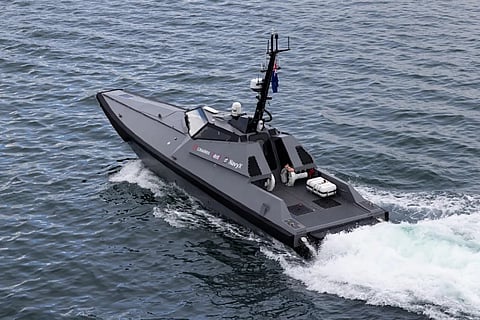

The UK Royal Navy has officially welcomed a new unmanned surface vehicle (USV) into service.
Named the Maritime Demonstrator For Operational Experimentation (Madfox), the 13-metre-long craft is derived from the Maritime Autonomy Surface Testbed (MAST), an existing high-speed USV developed for the Royal Navy by Florida-based defence and unmanned systems company L3Harris. The earlier USV has been undergoing extensive testing since being delivered to the navy in September 2019.
Like the standard MAST USV, Madfox is powered by a pair of Cummins engines connected to waterjets, and this arrangement has already proven capable of propelling the craft to a maximum speed of around 40 knots.
The newer USV is capable of fully autonomous sailing, while recent testing has shown it can also be controlled remotely by human operators using only portable devices such as laptop computers and tablets. This then means that remote operation of the craft and its onboard equipment is possible even without having to construct a dedicated control station that could otherwise consume more of the already limited space on any one of the navy's current surface ships or even the newer Type 26 and Type 31 frigates that will enter service within the decade.
Although the navy has not disclosed details on the craft's maximum endurance, information that has been made available reveals it can operate up to 48 kilometres out from a land- or ship-based controller, if needed.
Among the many sensors that have been incorporated on the USV are a Lowrance short-range radar, an electro-optical/infrared (EO/IR) camera that can collect high-resolution images under a broad range of weather conditions, and various other sensors for threat detection and identification. In addition to making the craft a viable platform for intelligence, surveillance, and reconnaissance (ISR) missions in support of a deployed naval task force, these features may also be utilised for covert, long-endurance monitoring of lower-intensity threats, such as criminal groups attempting to smuggle drugs by sea.
NavyX, the Royal Navy's own experimentation division, will continue its testing of Madfox while also examining how the vessel can be utilised across a wide range of military operations including surveillance and force protection. The navy expects the testing phase for the USV will last approximately one year, after which the craft will finally commence operational sailings with the fleet. Interestingly, some of the tests are being conducted jointly with the UK Border Force to determine the USV's suitability in supporting counter-narcotics and anti-illegal migration patrols in the English Channel and other congested waters.
| Madfox | |
| SPECIFICATIONS | |
| Type of vessel: | USV – Surveillance and force protection |
| Flag: | UK |
| Owner: | UK Royal Navy |
| Operator: | UK Royal Navy |
| Designer: | L3Harris, USA |
| Builder: | L3Harris, USA |
| Length overall: | 13 metres |
| Main engines: | 2 x Cummins |
| Propulsion: | 2 x waterjets |
| Maximum speed: | 40 knots |
| Radar: | Lowrance |
| Camera: | Electro-optical/infrared |
| Other electronics: | Various threat detection and identification sensors |
| Type of fuel: | Diesel |
